I have been reading a little lately about the transition from Classical Strategy to the Operational Art Strategy. A chap online ( Michael Powers@ BGG) posted a nice summary of how he uses Op Art (as its known. Well hell, that is what I call it) in his games.
I thought I would adapt some of his method and apply some structure to the game play of the Soviets in the Campaign 7.1-7.2 Operation Typhoon for GBII/CB. Ideally this will help form the basis of our After Action Reports also. There may not be the level of detail or turn by turn reports that we had with DAK2, more of a summary approach with deep dives where interesting or historically divergent events occurred. 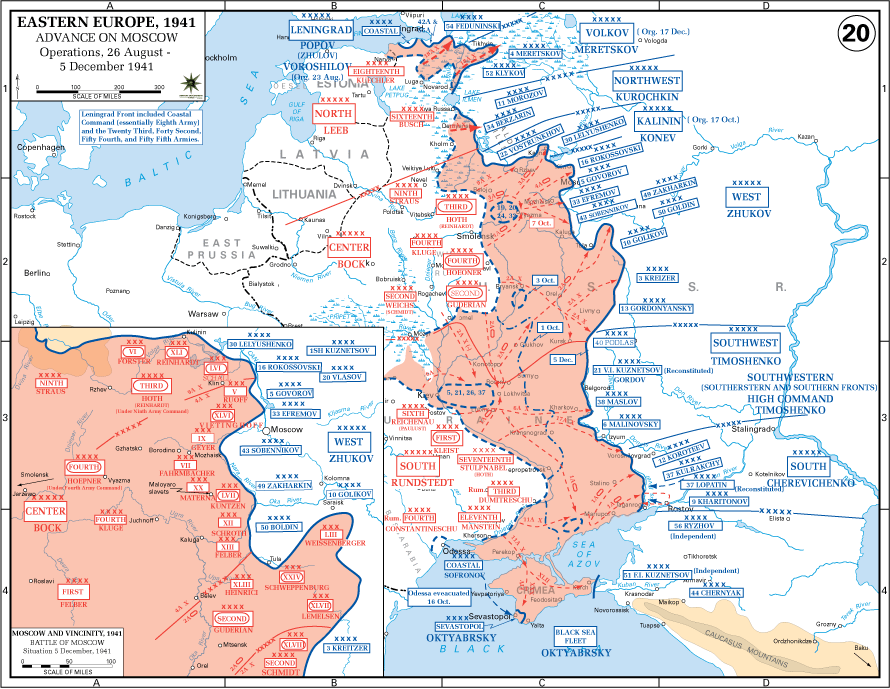 In the past we have used the OODA loop see the Bastogne AAR series of posts, Post#1, Post #2 , Post #3 , Post #4 , Post #5 and the wrap up to attempt to plan better and see if we really could influence the decision cycles of the opponent. This I think dovetails nicely with element discussed below.
In the past we have used the OODA loop see the Bastogne AAR series of posts, Post#1, Post #2 , Post #3 , Post #4 , Post #5 and the wrap up to attempt to plan better and see if we really could influence the decision cycles of the opponent. This I think dovetails nicely with element discussed below.
I thought it might be cool to “formally” or as formal as I can be, plan the scenario I am about to play using my interpretation of the core fundamentals of Operational Art, and leverage some of wonderful insights as well from the post on BGG. We are going to use Case Blue in the Operational Combat Series. 5 mile hex scale, units are Divisions down to Battalions. A system as you likely know focused upon Logistics and Maneuver (for those not familiar). My understanding of Operational Art and its core elements which I am still reading about is as follows:
Operational Vision (OV) Really a holistic approach. What is the Political or Theater wide goal or objective and what actions are required to produce such. What is the purpose? Which ties to:
Aim (A) Defined objectives, that drive us to achieve the political aim ( in this case very relevant as we are protecting Motherland and attempting to avoid an early close of the war (In Hitlers eyes anyway) against the Soviets. These Strategic Objectives will drive the intermediate and tactical planning under a tight OODA loop.
Flexibility & Distributed Maneuver (DM) Decentralized usage of forces applied to achieve the aims in a coordinated independent fashion. Analysis of ends, means, ways and risk. i.e. Attacks or in this case a defense across the entire system. The how, what , when,where and why of our plan and what our enemy is capable of. How will the enemy attempt to use simultaneous and sequential actions against us? How will he be prevented from doing this and what are /would be the related system wide effects?
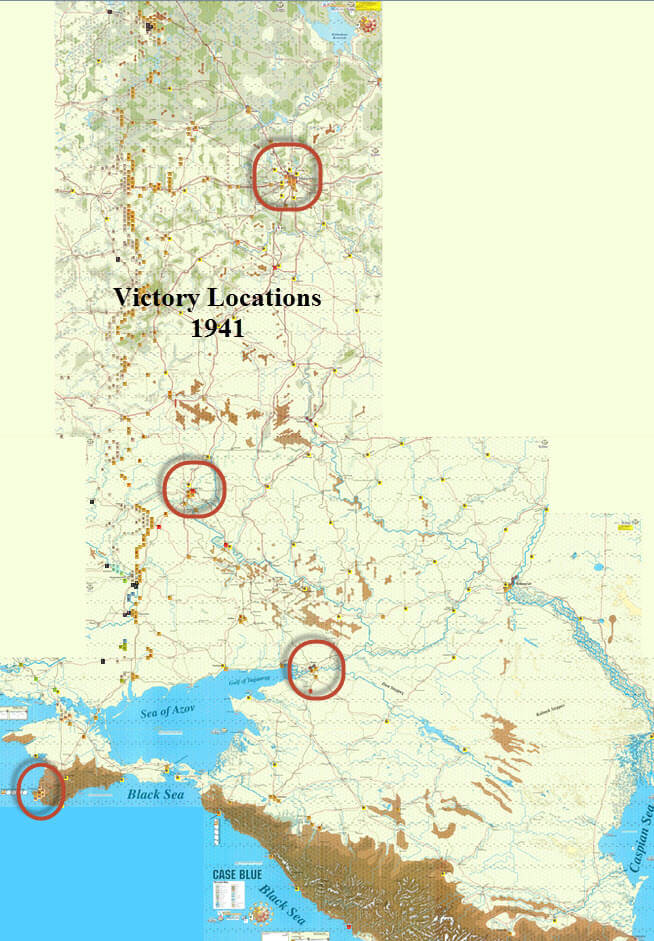
Command and Control (C&C): Breaks down into a couple of buckets namely –
–Lines of Communication areas of operation and areas of interest. Who goes where and why? –Logistics where will forces meet? Determine the reach of both sides, the cost to do so. This is the science of Op Art. How far can they get with how much, and when? -Ruse What avenues can be used to misdirect, offer distracting attacks and draw enemy forces away from the main thrust.
Center of Gravity (COG) A contested term. By looking at mutual strengths and weaknesses we can determine or create vulnerabilities and strong points. There in lie the decisive or critical points. Rivers, towns, hills, Supply depots, rail heads, bridging etc. End State (ES) How will a commander know he has achieved his goal, what will that look like? You will note that these are much higher level as I mentioned, and I often wonder if we displace meanings. The concept of Operational Art are really in my mind the linkages between Strategy and Tactics. They are not just a logistics plan. Simon Naveh wrote “that Military Force is an open system; its interaction of component parts is non linear and is dominated by aim.”
Op Art determines the missions and objectives that support the strategy, which in turn drive the tactics developed for that mission or objective. Here is another great definition of what Operational Art is from 1923 where Svechin (a Russian Military Theorist) proposed that operational art was “the totality of maneuvers and battles in a given part of a theater of military action directed toward the achievement of the common goal, set as final in the given period of the campaign.” Love that one! Let us see what CaseBlue/GBII has to offer us!
Our Vision and Aim [OV &A]: In the campaign set in October 1941 our mission and indeed political objective is to protect Moscow, Sevastopol and the other VC cities; Kharkov and Rostov. If the game extends beyond ’41 then the Axis must acquire in 1942: Grozny Fields OR Stalingrad, Moscow and Sevastopol. Simple…ahem. So our Strategy or Operational Vision is protection and defense of the National Capital, Moral and Political center of the country.
Thus we shall be securing our Soviet Political survival in WWII. There is of course some argument as to whether the Soviets would have collapsed in December/Jan if Moscow fell. We are here to fight a war not mull the intellectualism’s!!! At first glance this is a huge task for the Germans and equally for the Soviet brothers in arms. In both instances of ’41 and ’42 neither Moscow nor Sevastopol can fall together. Rostov, Kharkov are apparent affordable losses from a VC stand point but Moscow for sure is not. If Sevastopol is lost early in the war, this would free resources up to either target Moscow or prepare for the Strategic choice of Grozny/Stalingrad in 1942.
Sevastopol is hard to keep, but I think it can be made expensive to acquire in game terms. However in 1941 to protect either of the strategic VC locations (Grozny Fields OR Stalingrad), Rostov must be held! It is one of the gateways to the Eastern VP locations. Therefore a strong effort must be made in 1941 to keep this location. 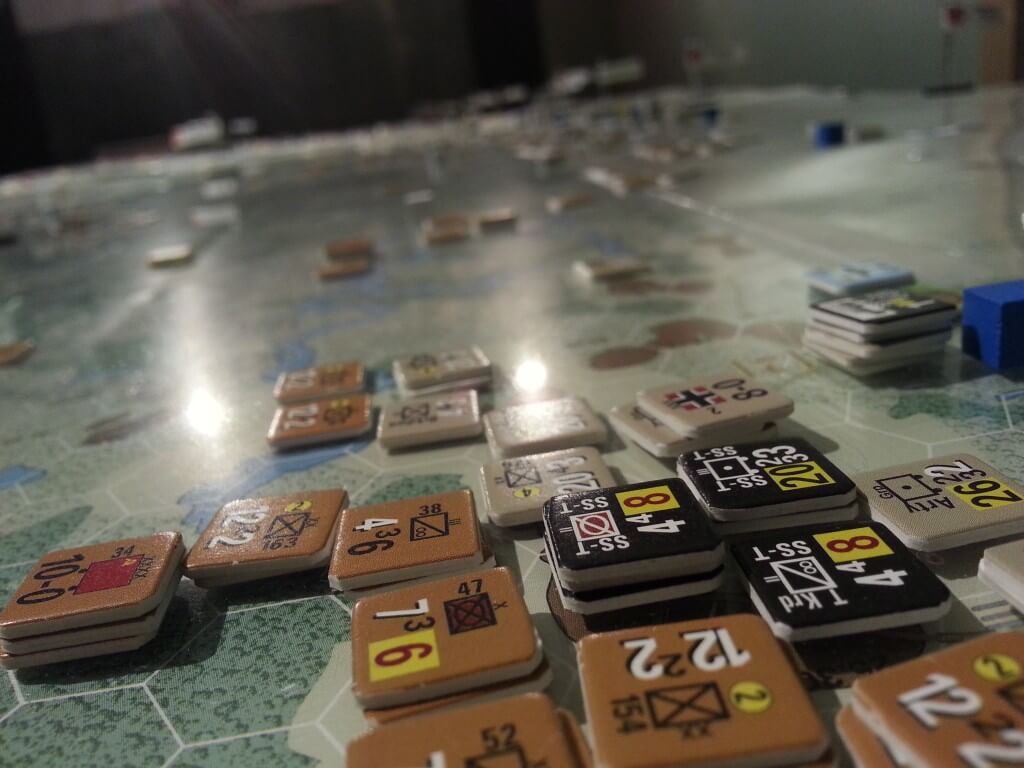 In the North of course Moscow must not fall. Kharkov is too far West to be a viable salvage point, so points further East would need to be identified to protect, but we are getting ahead of ourselves.
In the North of course Moscow must not fall. Kharkov is too far West to be a viable salvage point, so points further East would need to be identified to protect, but we are getting ahead of ourselves.
[DM] The Enemy and his capabilities: in raw capacity Axis forces are fast, mobile, and highly effective, but typically the best units are one step in size, thus susceptible to being brittle. They are limited by total supplies available and an inflexible transportation network. That and the game mandated transport losses, and reduced supply in the winter months hamstring any effort for a decisive win before December 31st 1941 via the capture of Moscow/Sevastopol. As a raw new player to CB/GBII it would appear Kharkov will fall quickly, and Sevastopol as well if the Axis set their minds to it. Several AARS have show us that a tenacious defense in the Rostov Front is possible. This should be kept in mind.
Ends, means and ways….We know from prior AARs, and endless forum discussions that the Axis can afford very few lines of supply for logistics transport on each map set [GBII/EATG/CB]. We also know that Rail and rail conversion will dominate and indeed limit their ability to project power. Other factors such as reinforcement entry points, locations of existing airfields and over run friendly terrain will play into the hand that the Axis attempt to deal to the Soviet defender. In order to deny DM we must factor the above into our chosen defense locations. These elements will drive the Lines of Communication and Logistics of the Enemy. The diagrams below highlight key areas that could be of interest to the Axis forces as they develop their attack plans. Will the Axis attempt Ruses? Will they try to keep the Soviets spread thin? If so how and where?
[CoG] 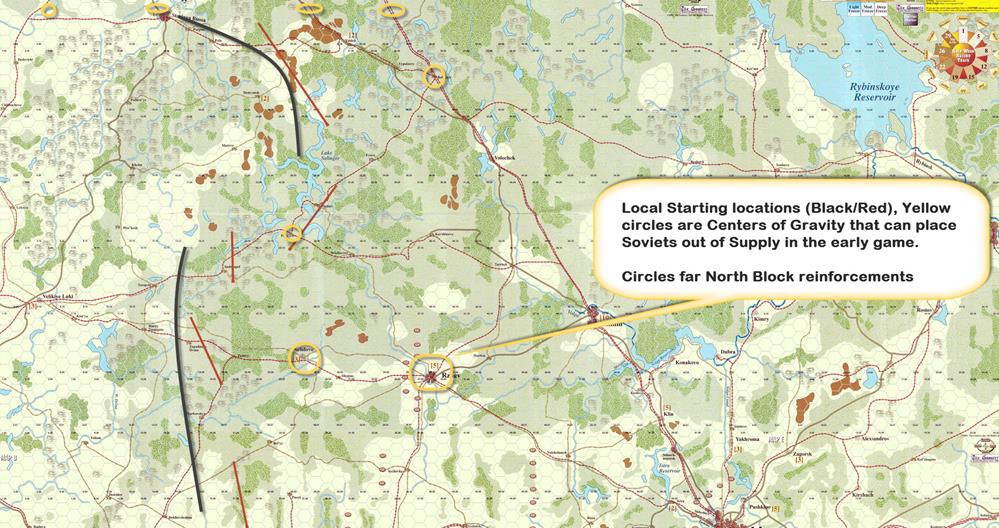
Northern Map GBII – North Moscow. One of the primary elements of the OCS game series is the fabulous way it brings together VP objectives to game mechanics. In any title you cannot just win by frontal assault and destruction of steps. The game rewards breaking the enemy via isolation, and attrition. Thus the ultimate goal of the Axis may be Rostov, however for them to acquire that target there are areas before and after that location that are key to success. Similarly in the North the Axis may race to Orel in turn one and capture it, and even fly in supplies to the captured airfield. But without a secure supply network or a converted rail line via various towns…it is for naught. The proper assessment and identification of CoG’s is vital, they are not VC towns!!! Should the Axis player choose the wrong approach the Soviets can make his life hell. IF however he chooses the right approach and it is properly defended life is hell also! 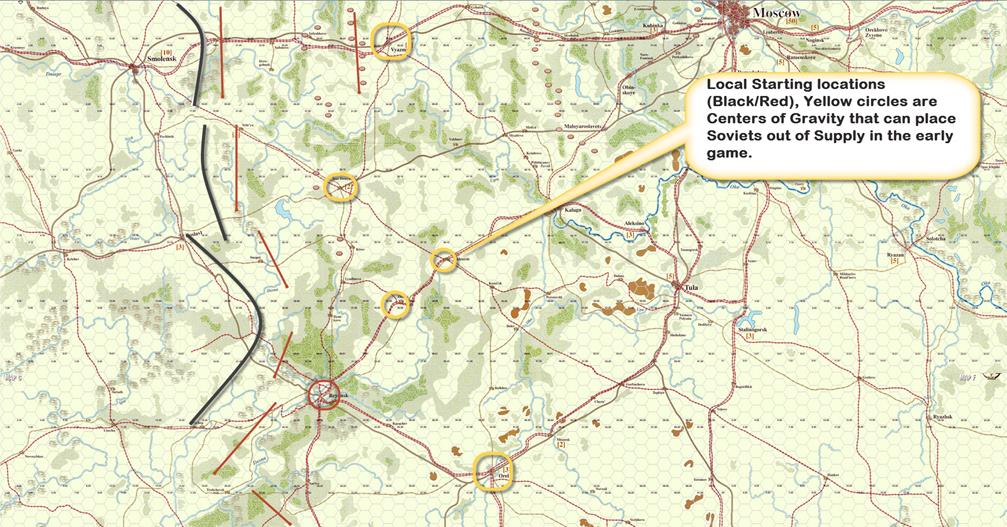
South Moscow-Orel For the Soviet player the CoG’s are all about then the SS. What? Yes the SS – Steps and Supply Points: No position is invulnerable from the German onslaught. If it can be surrounded, it is my understanding given time it can be beaten. Steps: If a location is of primary consideration to the Axis, the Soviet must make it costly in terms of steps spent to acquire it. This can be done in a number of ways. 1. Robust defensive lines – Hedgehogs, and proper mixes of high Combat Factor (CF) units combined with high value Action Rating (AR) units at key locations. Look at the chart from this post: http://wp.me/p3euWn-75VCnZ or see below: At odds in Open/Closed terrain of 4:1, 5:1 and 7:1 the attacker is going to lose a step if he wants the hex in 11 of 12 of the most likely results. The Soviet must force that loss! 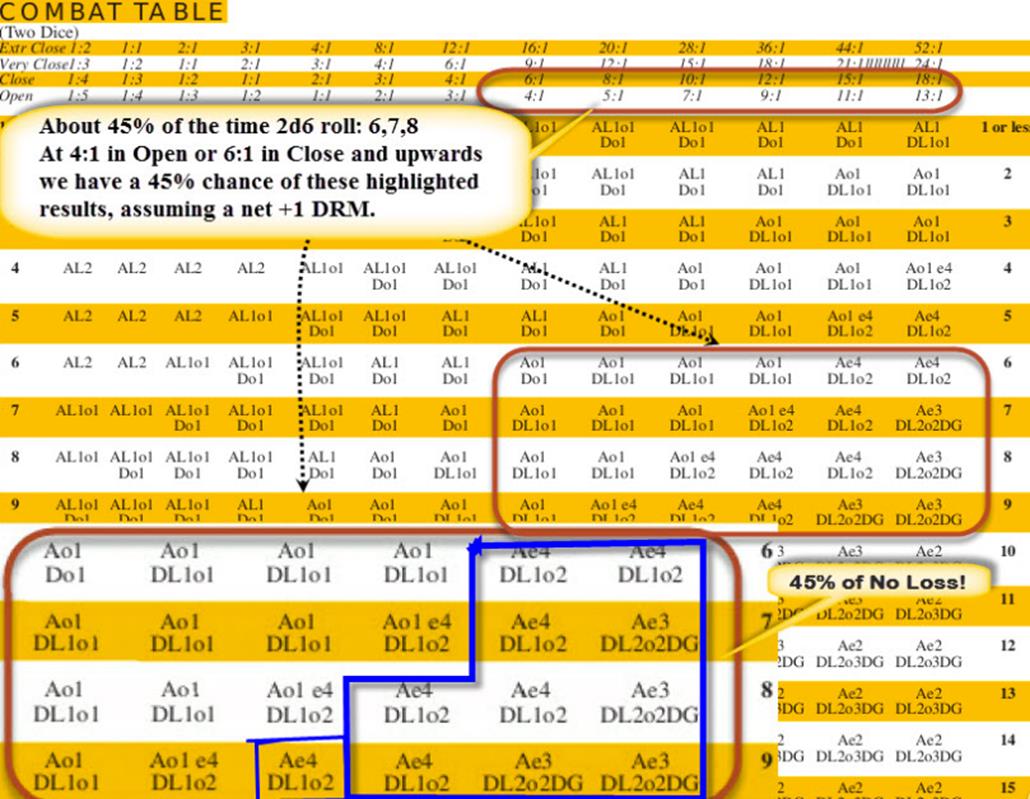 2.Spoiling attacks- As forces mass to attack, push units across the defensive boundaries to attack potentially weaker units or kill off a step of a formation that might be used for AR rating. Ignore your losses and grind away. I am still in two minds on this tactic, as it has gamey potential. “Soaking Up” SP as Germans refuse to defend at half strength, or forcing the risk of a ½ strength attack is both rational but potentially a pissy move. Yet I see the value and historic use. 3. Effective use of Reserves- keeping powder dry, especially units to drop into DG’d hexes, or Arty to DG an attackers stack or units to counter attack, or Air strikes on attackers are critical 4. Even when all is lost focus on surviving that one extra turn., and taking a step with you. 5. Counter Attack. If the game is about maneuver, and we want to deny that we must mount an attack that is savage enough to pause the Axis offensive or stop it all together. As referenced in Supply Points below the link to my exploration of the Counter Attack is detailed in another post.
2.Spoiling attacks- As forces mass to attack, push units across the defensive boundaries to attack potentially weaker units or kill off a step of a formation that might be used for AR rating. Ignore your losses and grind away. I am still in two minds on this tactic, as it has gamey potential. “Soaking Up” SP as Germans refuse to defend at half strength, or forcing the risk of a ½ strength attack is both rational but potentially a pissy move. Yet I see the value and historic use. 3. Effective use of Reserves- keeping powder dry, especially units to drop into DG’d hexes, or Arty to DG an attackers stack or units to counter attack, or Air strikes on attackers are critical 4. Even when all is lost focus on surviving that one extra turn., and taking a step with you. 5. Counter Attack. If the game is about maneuver, and we want to deny that we must mount an attack that is savage enough to pause the Axis offensive or stop it all together. As referenced in Supply Points below the link to my exploration of the Counter Attack is detailed in another post.
Make the Axis pay for each hex that matters. 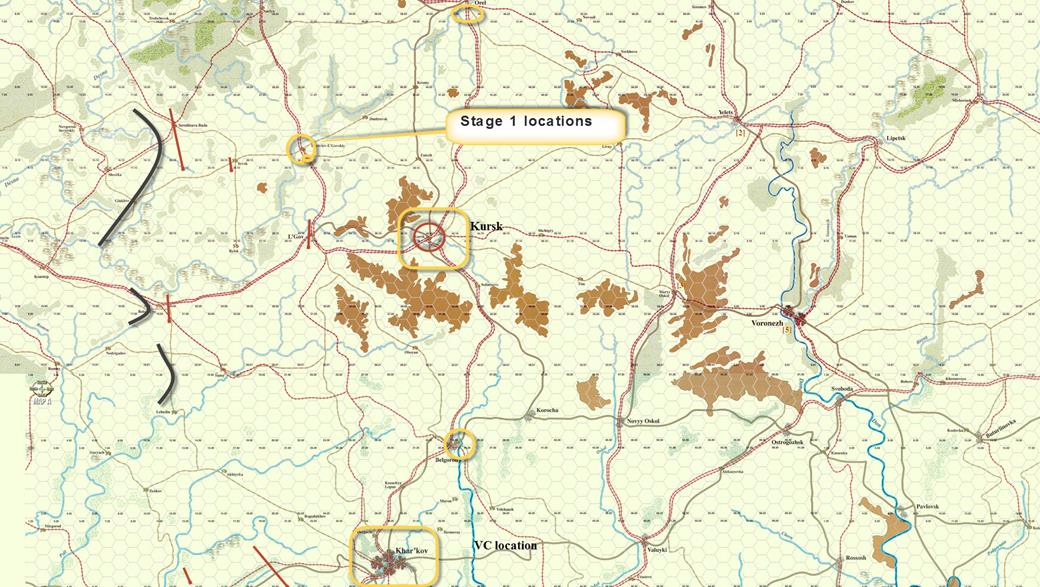
EATG/CB maps: Orel-Voro-Kharkov The other S… Supply Points: If the enemies have no SP they cannot move. As previously discussed http://wp.me/p3euWn-75VCl2 , the Germans forces in particular are more than a ‘fierce’ fighting force. They are a mobile force. Denying mobility helps win games. If they cannot move they cannot surround and isolate you! In my play attempting to identify SP dumps will not be a major factor as they will mostly be clearly marked. BUT….
Transport networks will not. Thus identifying where these networks are and mounting a formidable counter attack/attack into one of those locations that he will be FORCED to defend or recover is worth many turns of movement. In economic terms the Opportunity Cost is huge. 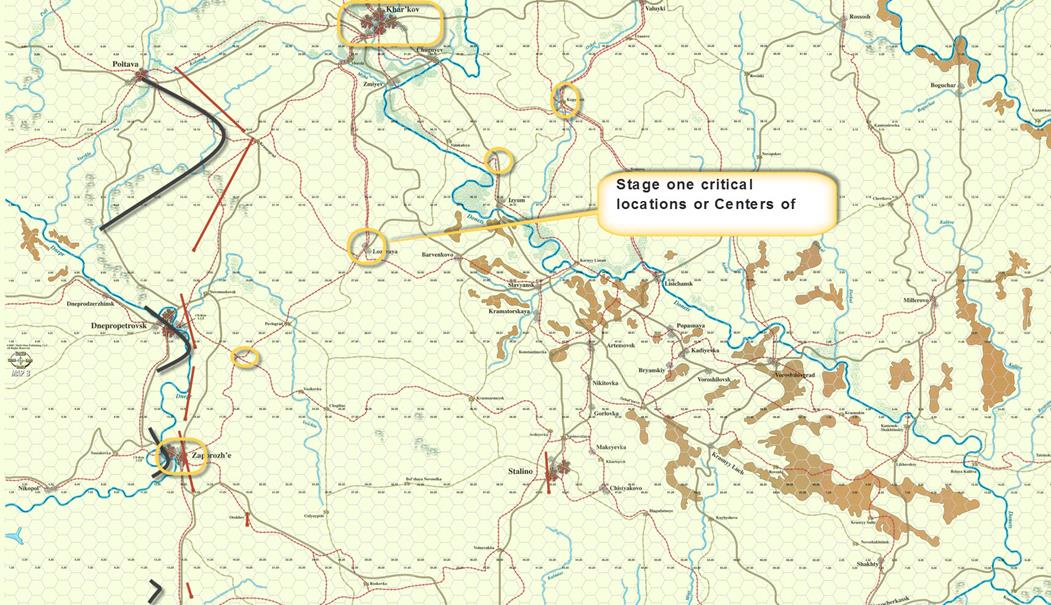
EATG/CB maps: Kharkov- Stalino Area Similarly forcing the Axis to use SP for non-movement related actions is highly valuable and desirable also. Making them use SP for defense, for a defensive Arty hit, on extra air sorties etc all add up. The Soviets also have the notion of the FRB, Forward Reserve Box(an ideal opportunity for the Soviets to develop their own Ruse, in essence a hidden force (but SP expensive) ready to pounce that can be built up over time. Using this effectively and the threat of up to 4 maritime landings in the South can tie up forces in the back field considerably. Spread throughout this article is a handful of images that highlight what I think are the Soviets major Centers of Gravity and focal points of the Distributed Maneuver to be watchful for in the opening stages of the game. In a later post I hope to outline how we will structure the Soviet defense with this in mind.
[ES] Well I probably mixed a fair bit of end state into the above. The Soviet player will know success. The Kremlin will stand alone at a worst. Axis forces will be clustered around supply hubs, and playing defensively. Your forces will be actively seeking counter punches not hole plugging. Worst case if all VP cities have fallen, a concerted effort to redeem one of them must take place and be successful prior to Dec 31st ! 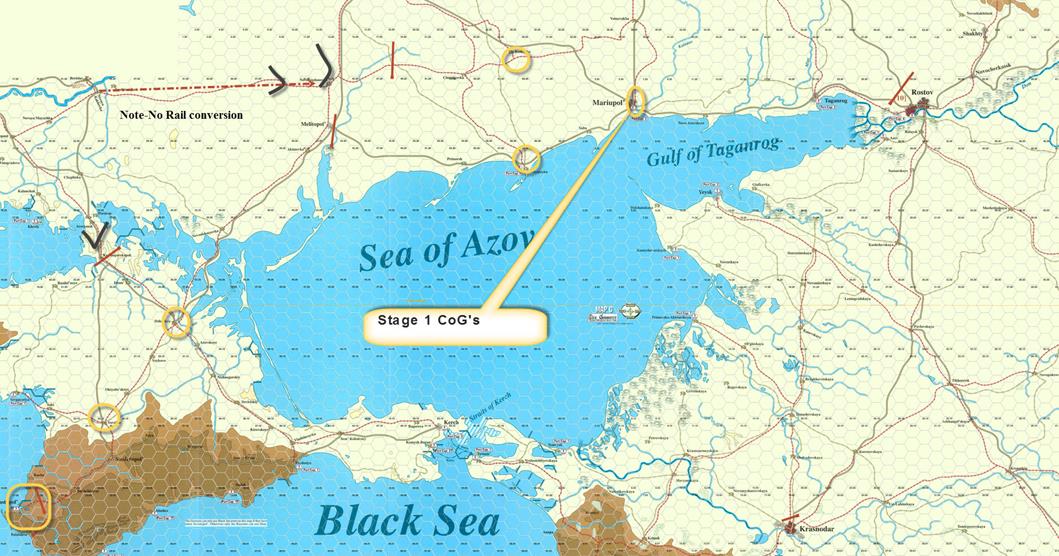
yes! its fun fun.